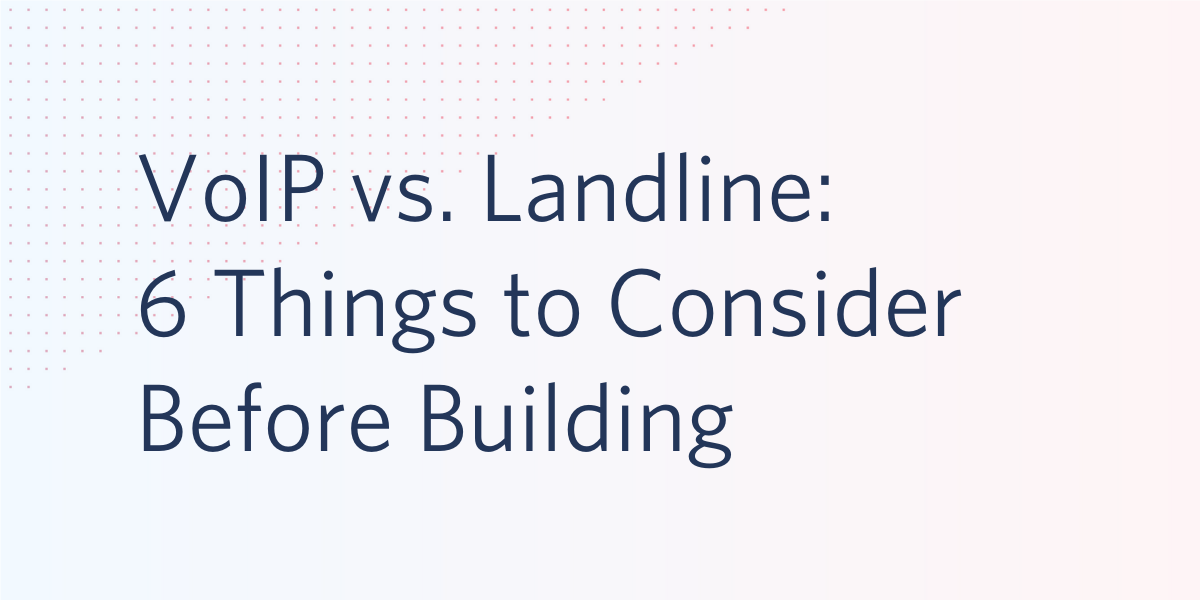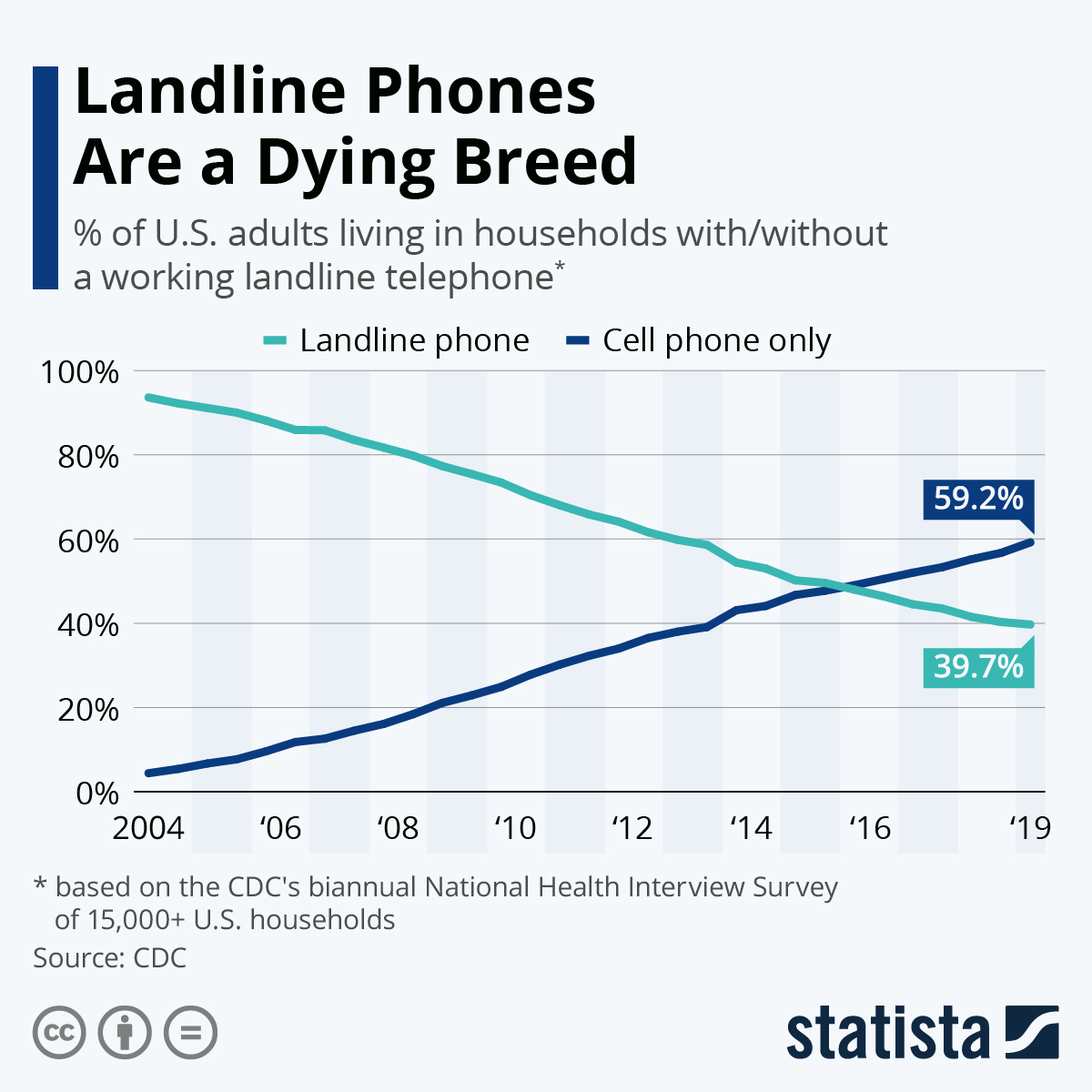VoIP vs. Landline: 6 Things to Consider Before Building
Time to read:
This post is part of Twilio’s archive and may contain outdated information. We’re always building something new, so be sure to check out our latest posts for the most up-to-date insights.

What should your business use for its phone system: VoIP (Voice over Internet Protocol) or the classic landline telephone? It's a good question, and one you may have never considered before with landlines practically disappearing from residential housing.
Seventeen years ago, more than 90% of US households had an operational landline phone. Fast forward to today, and it's now less than 40%. With smartphones becoming smarter (go figure) and a constant pocket companion, landlines are quickly losing relevance. And if the trend continues, there's no reason landline phones won't go the way of all technological relics—forgotten, much like VCRs, Walkmans, and floppy disks.

Landline Phones Are a Dying Breed, statista
If you're a Gen Z member, there's a good chance you've never even used a landline phone before. Gasp!
However, old habits die hard. Still, businesses debate VoIP vs. landlines. Which is more cost-effective? What solution has better call quality and connection reliability? Which phone system offers smoother scalability?
We hear you—we see you. Below, we'll outline the battlegrounds and help you identify the clear-cut winner in the great ongoing battle of landlines vs. VoIP.
6 VoIP vs. Landline Considerations
1. Pricing: Which Phone Service Will Save You Money?
Landline setup fees can get quite costly. You need a PBX (Private Branch Exchange) system, hubs, switches, telephone adapters, routers, phone sets, and copper wires connecting to the PSTN (Public Switched Telephone Network). Plus, you'll still need to pay a monthly fee to a provider.
It all adds up to be quite a lot.
VoIP, on the other hand, is much more cost-effective. Any phone with an internet connection can become a VoIP-enabled device—you can even use your old-school landline phoned on a VoIP service with the right adapter.
VoIP usually requires little-to-no setup fees, and different providers offer a host of affordable pricing plans. Most budget-friendly services use a pay-as-you-go model, so you only pay for what you use. Check out Twilio's Voice Pricing to see what costs you can expect.
VoIP is clearly the better choice here as it uses your internet connection to make calls, and there's an excellent chance you already have the internet set up. Cloud-based call rates are significantly cheaper than traditional phone line calls, making VoIP the more cost-effective solution in the short-term and long-term.
2. Call Management Features: Which Phone System Offers Greater Functionality?
Today's phone systems need to do more than just make and receive phone calls. Depending on the number of lines and extensions you need, plus the inbound and outbound traffic, you'll likely require several call management features:
- Auto-attendant: Empower your customers to self-serve or connect to the right person (the first time) with a multi-level voice menu system. Check out Twilio's IVR or menu tree flow to see what's possible.
- Call forwarding: Redirect or forward incoming calls to another number or device.
- Call recording: Record, store, and transcribe calls for historical records, training, or analysis.
- Call flipping: Transfer your in-progress call from a cell phone to a desk phone, desktop, tablet, or vice versa.
- Business integrations: Use popular CRM integrations and APIs to build custom-made voice solutions.
- Call analytics: Gain insights into network and device performance to uncover issues and improve call quality.
- And much more...
It is possible to access many of these features over a landline business system, but it usually requires an expensive PBX setup for your office. Plus, you'll likely need to pay an add-on price per feature, per month, on a landline.
On the other hand, most VoIP solutions include these features as part of their base product at no additional cost. Take Twilio's voice features, for example. You get call recording, audio playback, text-to-speech, real-time APIs, call queues, voice analytics, and so much more at no extra cost.
VoIP has all the features you need for a professional, scalable calling experience. Plus, the features are more affordable and continue to be updated and improved.
3. Device Flexibility: Which Phone System Allows for Various Devices?
A virtual phone system allows you to make and receive calls from anywhere, at any time, on any device: smartphone, tablet, laptop, desktop, desk phone, etc. With VoIP, you'll never miss an important call because you were out of the office.
Features like call flipping make it convenient and straightforward to switch seamlessly between devices—your client won't even notice. If you take a call on your desk phone but need to leave, flip the call to your smartphone—no need to interrupt your conversation with, "I'll call you back in a minute on my cell."
Landline systems can be set up to automatically route calls from a landline to a cell phone with the star code option, but the advanced functionality ends there. VoIP solutions can be set up to ring multiple phones and laptops simultaneously (or in sequential order) to guarantee quick response times and no unanswered calls.
4. Emergency Services: Which Phone Service Is Better for 911 Calls?
Many first-generation VoIP service providers don't support emergency calls, which can be a big problem. VoIP phone numbers aren't dependent on a location, so 911 dispatchers struggled to send emergency services to the right location when a physical address wasn't provided during the call.
However, things have evolved since the early VoIP days. Now, most VoIP providers enable E911 calling (however, always check with your provider to make sure). Providers will require your address when you're setting up your account and allow you to update it as necessary.
There's still a risk that you lose power or internet access and can't place an emergency call. And if you moved (or aren't home) and didn't update your physical address to the provider, emergency personnel might not be able to respond as quickly.
Twilio provides both E911 and Basic 911 calls:
- E911 Calls: Calls are routed to the Public Safety Answering Points (PSAPs) and automatically transmit your phone number's associated Twilio phone number and provided address.
- Basic 911 Calls: Calls are routed to the PSAP serving your number's address, but the dispatcher will not receive your phone number or address unless you provide this information verbally during the call.
On the other hand, landlines are basic and easier to use for emergency services. A traditional landline is easily traced to a specific location, making it easy for dispatchers to automatically know your whereabouts without verbal confirmation.
In this case, landlines are the best choice. While VoIP has come a long way in enabling emergency services calls, landlines still win out for their simplicity and reliability.
5. Call Quality and Reliability: Which Service Can You Trust?
Landlines are reliable for quality sound and few dropped calls. However, call quality over VoIP is dependent on the strength of your internet connection. If you have high-speed internet, you'll likely have zero issues with call quality.
VoIP gives you a little bit more control over your call quality, though. If you're not satisfied with the sound, you could always plug in a headset or microphone to adjust it to your liking. However, a power outage could knock out your calling ability if you don't have a backup system in place.
There is no winner here as both landlines and VoIP have their own tradeoffs. While landlines have more consistent call quality, VoIP calls tend to sound better, although they depend on a strong internet connection and sufficient bandwidth.
6. Scalability: Which Service Is Easier and More Affordable to Scale?
Scaling with VoIP is inexpensive and straightforward. You'll usually have to pay for additional lines, numbers, and extensions, but it's as easy as click, click, click—no additional on-premise charges or copper wiring required. Digital upgrades and maintenance are often automatic, keeping your system up-to-date with the latest technology and software.
Scaling landline phone systems is a bit trickier. You'll likely need more phone sets and wired phone lines to add more users and scale your business—and you'll probably need to pay a provider to come and install it all.
With that said, it's worth giving the last winning point to VoIP. VoIP is easier and more cost-effective to scale up and down to meet your businesses' changing demands.
And the Winner Is...
VoIP.
But you knew that was going to be the answer all along, didn't you? Yes, landlines take a slight (very slight) edge when it comes to emergency calling and consistent sound quality, but VoIP wins out in every other way.
Want to learn more about VoIP and how it works? Discover all the nitty-gritty details you could ever want to know (and then some) about VoIP in our Fundamentals of VoIP (Voice Over Internet Protocol) article.
How to Port Your Landline to VoIP
If you're convinced a VoIP phone system is the right solution for your business, head on over to Twilio and get started with a free account—no credit card required.
But what if you already have a landline service and want to switch to VoIP? Not a problem! Check out Porting a Phone Number to Twilio to walk through the simple 6-step process. It'll show you everything you need to do to submit your port request, transfer your number, and start using your number on Twilio.
Related Posts
Related Resources
Twilio Docs
From APIs to SDKs to sample apps
API reference documentation, SDKs, helper libraries, quickstarts, and tutorials for your language and platform.
Resource Center
The latest ebooks, industry reports, and webinars
Learn from customer engagement experts to improve your own communication.
Ahoy
Twilio's developer community hub
Best practices, code samples, and inspiration to build communications and digital engagement experiences.